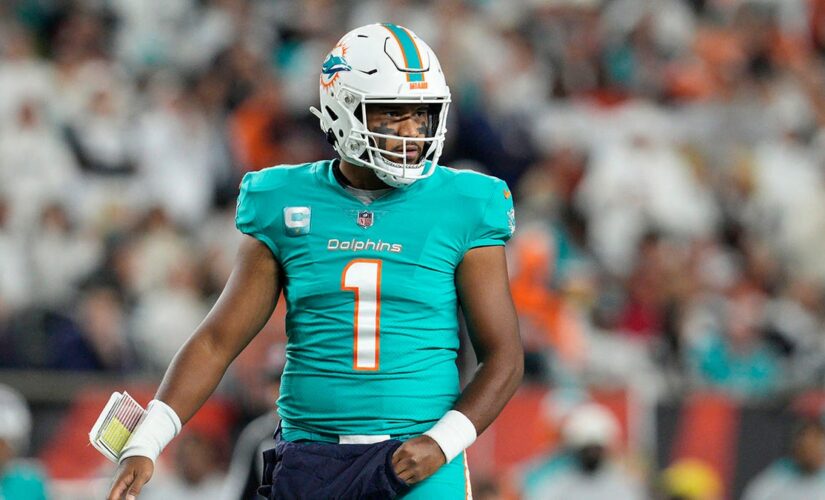Did you know that a concussion is a type of traumatic brain injury?
After Miami Dolphins quarterback Tua Tagovailoa was transported to the hospital on Sept. 29 after his head slammed into the ground during a game against the Cincinnati Bengals — the second blow to his head in a span of four days — the evaluation and management of head injuries ignited a national conversation about how best to manage concussions, according to multiple reports.
Approximately 7% of children have had symptoms of concussion or a brain injury in their lifetime.
TUA TAGOVAILOA CLEARS CONCUSSION PROTOCOL, EYES POTENTIAL WEEK 7 RETURN
Yet the risk increases with age — from 2% in those five years and younger to an estimated 12% in children aged 12-17, according to the National Center for Health Statistics.
An estimated 29% of adults self-reported experiencing a concussion in their lifetime, according to a recent research study.
Quarterback Tua Tagovailoa of the Miami Dolphins warms up prior to the game against the Cincinnati Bengals at Paycor Stadium on September 29, 2022, in Cincinnati, Ohio.
(Andy Lyons/Getty Images)
Here’s a deeper dive into the issue.
What is a concussion?
“A concussion is a type of mild traumatic brain injury (or mild TBI),” said Dr. Mitul Kapadia, medical director of pediatric rehabilitation and co-director of the sports concussion program at UCSF Benioff Children’s Hospital, San Francisco.
“It happens when a blow to the head or an injury makes the head move back and forth with a lot of force,” he said.
“Patients who have experienced a concussion show a complex range of neuronal and metabolic changes, and the mechanism of injury is likely associated with shearing of nerves.”
He told Fox News Digital that this causes chemical changes in the brain and sometimes damage to the brain cells.
“Patients who have experienced a concussion show a complex range of neuronal and metabolic changes, and the mechanism of injury is likely associated with shearing of nerves,” added Dr. Oren Gottfried, professor of neurosurgery and clinical vice chair in the department of neurosurgery at Duke University in Durham, North Carolina.
Loss of consciousness is not a requirement for a diagnosis of a concussion — but a concussion is graded as mild, moderate or severe, depending on the duration of consciousness and memory loss, or amnesia, that persists after the injury, according to multiple reports.
Signs and symptoms of concussion
Symptoms as experienced by the patient can vary from “just not feeling right” or “feeling down” to having a headache, blurry vision, difficulty concentrating, feeling dizzy or feeling sluggish, according to the Centers for Disease Control and Prevention (CDC).
Signs are what an observer, such as a parent or coach, can see.
The signs can include: appearing stunned, confused, answering questions slowly, experiencing personality changes or having difficulty in following instructions.
Miami Dolphins quarterback Tua Tagovailoa (#1) aims a pass during the first half of an NFL football game against the Buffalo Bills, Sunday, Sept. 25, 2022, in Miami Gardens.
(AP Photo/Rebecca Blackwell)
“The Concussion in Sport Group has outlined the signs and symptoms below as ‘red flags,’ meaning that if an athlete experiences/displays them, they should be transported to a hospital — these signs/symptoms can indicate an injury more severe than concussion,” said Dr. Steve Broglio, director at the University of Michigan Concussion Center.
He noted these symptoms include neck pain or tenderness, double vision, numbness, severe or worsening headache, seizure or convulsions, loss of consciousness, vomiting or being increasingly restless, agitated or combative.
When to seek medical attention
“The single biggest thing is to remove any athlete from play who is suspected of having a concussion until that person can be evaluated by a licensed medical provider,” Broglio told Fox News Digital.
If parents think their teen may have a concussion, the CDC recommends first removing the teen from play, keeping the teen out of play on the day of injury — and having the teen evaluated by a health care professional.
“A health care professional will inquire about the details of the injury and also perform a comprehensive physical exam to determine whether further workup is needed.”
“As a neurosurgeon who treats head injuries, I would recommend that anyone who has suffered a trauma resulting in any period of loss of consciousness that is witnessed — or if they were alone and are vague or confused on the details of the injury — to get assessed by a doctor in urgent care, [be seen] in the [emergency department], or [make a] same-day visit to your physician,” Gottfried told Fox News Digital.
“Also, anyone who did not have any loss of consciousness but has persistent symptoms including headaches, neurological [issues] or any of the [symptoms] associated with post-concussive syndrome needs to be assessed,” he added.
When is it OK to return to play?
A health care professional will inquire about the details of the injury and also perform a comprehensive physical exam to determine whether further workup is needed, Gottfried noted.
“The provider has the training to fully evaluate the athlete and decide if they can return or not,” Broglio added.
Washington became the first state in the union to require a “removal and clearance for Return to Play” among young athletes in May 2009 — but now all 50 states have a similar law, according to the CDC.
Who should get a CT scan?
After a patient is evaluated, a health provider may sometimes decide to order a CT scan for the person.
“A CT scan of the brain takes pictures to create images of the brain and can show if there’s a fracture or bleeding,” Kapadia told Fox News Digital.
Not everyone who is evaluated will require a CT or MRI, said one medical professional — but only a provider experienced in head injuries should make this decision.
(iStock)
“A CT scan cannot show if you have a concussion — and [these scans] are not routinely ordered for concussions unless a doctor has concern for a fracture or bleed.”
Gottfried noted that not everyone who is evaluated will require a CT or MRI, but only a provider experienced in head injuries should make this decision.
Monitor the patient for signs and symptoms
The symptoms of a concussion generally occur right after the injury, but sometimes the symptoms may not show up until hours later, according to the CDC.
The agency recommends monitoring for signs of a concussion soon after the injury and for several days later. If the signs of symptoms are worsening, then the person should be taken to the emergency department immediately.
What is second impact syndrome?
Concussions need to be treated appropriately because the initial injury reduces the brain’s “resilience” and alters its ability to compensate, Gottfried said.
But a second injury to the head before the brain has had time to completely recover can be fatal sometimes. “Second impact syndrome (SIS), also known as repetitive head injury syndrome, occurs when an individual experiences a second head injury before complete recovery from an initial head injury,” Gottfried said.
“The most common scenario is in athletes who suffer a concussion and return to their sport too early.”
Some factors can also delay recovery from a concussion, such as a previous concussion, neurological disorders, learning difficulties or mental health issues.
He noted a subset of people are genetically predisposed to an overactive response to concussion as well as a secondary injury.
CLICK HERE TO SIGN UP FOR OUR LIFESTYLE NEWSLETTER
Some factors can also delay recovery from a concussion, such as a previous concussion, neurological disorders, learning difficulties or mental health issues — as well as family or social stressors, per the CDC.
“The catastrophic second impact injury results from the loss of normal regulation of blood flow to the brain, leading to massive brain swelling,” Gottfried added.
“The rise in pressure is rapid and can even result in brain herniation and death.”
NFL modifies its concussion protocol
The NFL and NFL Players Association (NFLPA) agreed to modify the league’s concussion protocol after Tagovailoa suffered repeated head trauma last month.
“Following the complete review, the parties concluded that while the step-by-step process outlined in the Concussion Protocol was followed, the outcome in this case was not what was intended when the protocol was drafted,” a joint NFL-NFLPA statement said.
CLICK HERE TO GET THE FOX NEWS APP
The concussion protocol will add the symptom of “ataxia” to “no-go” symptoms, in which a player will be prohibited from returning to the game and will receive follow-up care outlined in the protocol if a player is diagnosed with this condition.
It defines ataxia “as [the] abnormality of balance/stability, motor coordination or dysfunctional speech caused by a neurological issue.”




